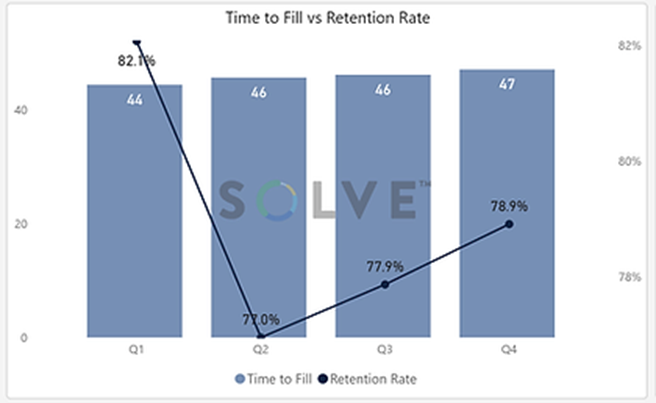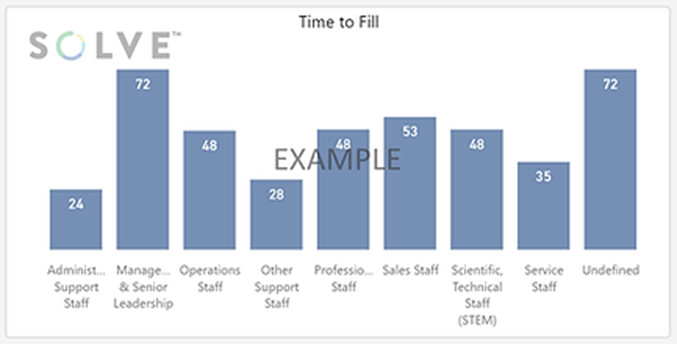Time is of the essence when it comes to hiring new employees. It can be hard to find quality candidates quickly, while still ensuring they’re the right fit for your business. That’s where Time To Fill – or TTF – comes in. TTF is a metric used by companies to measure how long it takes them to fill open positions with a successful hire. But what does Time To Fill mean for businesses and how can you use it effectively? In this blog post, we’ll discuss what Time To Fill is and how businesses can leverage this metric for success!
What is time to fill?
Time to Fill is an important metric for measuring the efficiency of your recruitment process. It tells you how long it takes, on average, to fill a role from the point when the job is first advertised. This metric can be used to compare different roles, different departments or different stages in the recruitment process. For example, if you find that Time to Fill is increasing for a particular role, it could be an indication that your job advertisements are not reaching the right candidates. Alternatively, if Time to Fill is increasing for all roles, it could be an indication that your recruitment process is taking too long. Time to Fill is therefore an important metric for understanding the efficiency of your recruitment process and improving your overall hiring strategy.
Why Is It Important For Startups To Track This Metric?
Here are a few reasons why it is important to track time to fill:
- It can provide insights into the effectiveness of recruiting efforts – By tracking time to fill, startups can gain insight into how effective their recruiting strategy is and make necessary changes or adjustments where needed.
- It helps to identify potential bottlenecks in the recruitment process – If a startup notices that its average time-to-fill is increasing, it can help identify potential bottlenecks in the recruitment process and address them.
- It provides an understanding of the current state of hiring – By tracking time-to-fill startups can gain insight into their candidates’ journey from when they apply to when they are hired. This helps give a better understanding of the hiring process and how it can be improved.
- It helps to manage expectations – Tracking time-to-fill allows startups to set realistic expectations with potential candidates by providing them with a timeline of when they could expect an offer or job acceptance.
- It allows startups to benchmark performance against industry standards – By tracking and monitoring time-to-fill, startups can compare their performance against industry standards and identify areas for improvement.
By tracking time to fill, startups can gain valuable insight into their recruitment process and make necessary changes or improvements. This is important if they want to remain competitive in the ever-evolving startup landscape. With this data, startups can see where they can become more efficient in the recruitment process and optimize their hiring strategy for maximum results.
How do you calculate Time to Fill?- Rewrite
Hiring can be a lengthy process – but how do you know if it’s taking too long? One way to measure this is by calculating your ‘Time to Fill’, which is the average number of days it takes to hire a role. To calculate this, you’ll need to count the calendar days between your starting point (e.g. when the role is launched on your careers site) until the role is filled, for each role. Then use the following formula:
( Time to Fill position 1 + Time to Fill position 2 + … + Time to Fill position n ) / # of roles recruited for in that time period = Time to Fill
For example, if you have hired three Engineers with 30, 40 and 50 days time to fill respectively, then your average time to fill is (30+40+50)/3 = 40 days.
Time to fill can be a useful metric for benchmarking against similar roles or other businesses in your industry. If you find that your time to fill is consistently higher than average, it could be an indication that there are improvements you can make to your hiring process.
What are the effects of Time to Fill on a startup
Here are the effects of time to fill on a startup:
Increased Costs
Hiring costs can quickly add up if you take too long to fill open positions in a startup. Longer time to fill means more money spent on job postings, employee referrals, applicant tracking systems and other recruitment tools. This can put a strain on a company’s budget or cash flow.
Loss of Productivity
When a startup does not fill positions in a timely manner, it can lead to a decrease in productivity since the team is operating at less than full capacity. This means tasks may take longer to complete or be handled inefficiently because there are too few people doing them.
Missed Opportunities
A startup may miss out on a great candidate if they take too long to fill a position. By the time they realize their mistake, the candidate may have accepted another offer or become uninterested due to the prolonged waiting period.
Low Morale
Longer wait times for job positions lead to frustrated candidates who no longer view your company favourably. Low morale can also affect current employees who are put under more pressure to fill the missing roles or handle more duties than usual.
Bad Reputation
If your startup takes too long to fill positions, it may lead to a negative reputation in the industry as people perceive you as slow and inefficient. This can hurt your ability to attract top talent in the future.
Loss of Competitive Edge
Time to fill has a direct impact on a company’s competitive edge as it affects its ability to quickly and efficiently react to changing market conditions or take advantage of new opportunities. This can put them at a disadvantage compared to companies that move faster when it comes to hiring.
By reducing the time to fill, startups can avoid these negative impacts and ensure they have the right resources in place to thrive. Taking steps such as streamlining their recruitment process, building relationships with potential candidates and offering competitive salaries are some of the most effective ways to reduce time to fill. The ultimate goal should be to deliver an amazing experience to candidates so they can become part of your team as quickly and efficiently as possible.
What factors affect Time to Fill?
Here are the factors that affect time to fill:
Job Requirements
Different roles require different skill sets and experience levels, which can impact the time it takes to fill a position. For example, if you’re hiring for a senior-level role that requires niche or specialized skills, it may take longer to find the right qualified candidate than if you were looking for an entry-level position.
Geographic Location
The size and talent pool of a given geographic area can affect the time to fill a role. For example, in a smaller market with fewer available candidates, it may take more time to find the right fit than if you were looking for someone in a larger city or metropolitan area.
Hiring Process
Your hiring process and the number of steps you require can also affect time to fill. For example, if you have an extensive screening and interview process, it may take longer for a candidate to successfully progress through each stage than if you have a simpler or shorter process.
Competition
Competitors in your industry may be looking for the same candidates as you, or maybe offering more attractive compensation packages. This can lead to longer time to fill a role since you’re competing with other employers for the same talent pool.
Brand Awareness
If your organization is relatively unknown in comparison to competitors, it can take longer to fill roles as potential candidates may be unaware of your opportunities. To reduce time to fill, consider building a strong employer brand and promoting it to attract top talent.
Recruiting Channel
Where you’re recruiting can also impact the length of time it takes to fill a role. For example, if you’re only using traditional methods such as job boards and recruitment agencies, you may miss out on top talent that can be found through modern methods such as social media or employee referral programs.
By understanding the factors that affect time to fill, you can create a recruiting strategy that helps reduce the time it takes to find qualified candidates for your open roles. With more efficient hiring processes, you can ensure that you’re bringing the right talent onboard faster.
What is a good Time to Fill?
The average time to fill a position is 42 days. However, this number can range from 14 to 63 days, depending on the industry in which the position is located. For example, in 2018, the hospitality industry saw the shortest time to fill, averaging at 10.2 days. This is likely due to the fact that there are many entry-level positions available in the hospitality industry. In contrast, the healthcare industry saw the longest time to fill, averaging at 63 days. This is likely due to the fact that there is a shortage of qualified healthcare workers. As a result, employers in this industry must take more time to find qualified candidates. Ultimately, the time it takes to fill a position varies depending on a variety of factors.
What are examples of Time to Fill
Here are some examples just for you:
Benchmarking with industry average and peers
Benchmarking with peers and the industry average is a great way to see how your company measures up. According to SHRM’s Talent Acquisition Benchmarking Report, the average Time to Fill is 36 days. Note that the average Time to Fill differs substantially between industries, types of positions, and hiring locations. Some positions have a smaller talent pool and therefore naturally take longer to fill. For example, the current skilled nursing shortage makes it hard for healthcare providers and hospitals to recruit bedside RN nurses. The average
The time to Fill this role is 54 days which is significantly higher than the 36 days cited in SHRM’s report. There is also a big gap between the top and bottom-performing teams. While it takes the top-performing recruiting teams on average just 34 days to fill an empty position, the bottom teams take as much as twice as long. This shows that there is room for improvement for many companies. Using benchmarks is a great way to see where you stand and where you can make changes to improve your recruiting process.
Cross compare
There’s no denying that a strong recruitment process is crucial to the success of any organization. After all, attracting and hiring top talent is essential to stay competitive and achieve long-term goals. But what exactly makes for a strong recruitment process? Many organizations focus on Time to Fill, or how quickly an empty position is being filled. While this metric is certainly important, it’s only one piece of the puzzle. The quality of new hires, cost per hire, and retention rate are just as important to recruiting performance. That’s why we recommend that HR cross-compares
Time to Fill with other employee metrics such as quality of hire metrics or indices, engagement scores, and retention rates for better insights into the talent pipelines. In the below example, you can see that Time to Fill is growing slowly over time. Taking one or two extra days to fill an empty position would not be a big concern if recruits are highly engaged and more likely to stay.
But in this case, not only is Time to Fill taking longer, but the average Retention Rate is also decreasing. This could be a sign that something is wrong with the recruitment process and that new hires are not being properly vetted or supported after they’re onboarded. By comparing different employee metrics, organizations can get a more holistic view of their recruitment efforts and make necessary changes to ensure long-term success.

Discover additional Insights by Filtering
As illustrated in Time to Start, we recommend that HR filter Time to Fill by measurement dimensions such as workforce category, critical job groups, business unit, performance category. In doing so, management can use Time to Fill as a predictor of improved recruiting operations, increased workforce productivity and lowering total cost of workforce.

What are tips To decrease Time to Fill?
When it comes to hiring new employees, one of the most important factors to consider is the time to fill. This is the amount of time that elapses between when a position is created and when it is filled with a qualified candidate. A long time to fill can have a number of negative consequences, including decreased productivity, higher labour costs, and missed opportunities. Here are a few tips to help decrease your time to fill:
- Use an applicant tracking system (ATS). An ATS can help you keep track of candidates and automatically screen applications for key qualifications. This can save you a lot of time in the hiring process.
- Develop a clear job description. A well-written job description will help attract qualified candidates and make it easier to weed out those who are not a good fit for the position.
- Utilize social media. Social media platforms like LinkedIn can be a great way to reach out to potential candidates and connect with passive job seekers.
- Work with a staffing agency. Staffing agencies specialize in finding qualified candidates for open positions. They can be a valuable resource in filling your vacant position quickly.
By following these tips, you can decrease your time to fill and make the hiring process more efficient.
Conclusion
Time to fill is an important metric for any organization that relies on employees to get work done. It provides a way to measure how quickly or slowly an organization is able to fill vacant positions. By understanding what time to fill is and how it’s calculated, businesses can make better decisions about their hiring practices.

